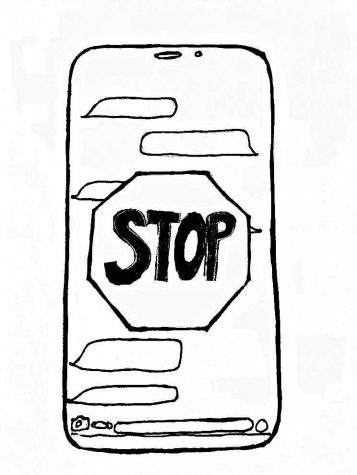Shift the gears on who’s really in need of distracted driving education
March 23, 2019
The statistics are frightening. One out of every four accidents in the United States (1.6 million crashes and over 390,000 injuries each year) are caused by phone use while driving, according to the National Safety Council. The numbers alone, along with the occasional texting and driving PSA on YouTube and the never-ending stern reminders from parental figures, are enough to keep a teenager such as myself away from my phone while I’m behind the wheel. I have confidence that I am a safe and alert driver, keeping music to a volume just low enough to hear emergency vehicles, yet high enough to drown out the sound of my defroster. I always mute my text messages and other notifications while I’m driving.
Despite my efforts, it feels as if I am still doubted when it comes to my ability to stay focused behind the wheel just because my age ends with the word “-teen.” The public service announcements almost always feature depictions of teenagers

laughing in crowded cars, the driver looking away for a moment to check their phone, followed by an instantaneous and horrifying collision. But why just teenagers? Why is it that the first image conjured up of an unfocused driver involves my age group? There is a distinct lack of accountability among adults when it comes to distracted driving and phone use, and it seems almost natural at this point that younger generations are being held responsible for matters that fall into almost everyone’s hands, regardless of age.
Don’t let the stigma fool you: while it may be easier to believe that teenagers are responsible for most of the collisions caused by phone use, 49 percent of adults over the age of 18 reported to USA Today that they use their cell phones while driving, despite 98 percent of this group understanding that this is dangerous. Meanwhile, 43 percent of teenagers under the age of 18 reported using their phones while driving, a slightly lower percentage compared to adults. While these numbers aren’t too far off from one another, it goes to show that teen drivers can no longer be the only ones held accountable for distracted driving. Adults are just as likely, if not more likely than teens to use their phones while driving. Furthermore, 87 percent of Redwood students have witnessed their parent or guardian text while driving, according to a recent self-reported Bark survey. Despite the apparent lackluster driving habits of some adults, the stigma remains that high school-aged drivers are notoriously guilty of texting and driving.
This stigma is one we’ve all probably been affected by as high school students. It feels as if there is constant criticism about our generation and our phone use, but in reality, older generations aren’t so different. In fact, our skills with technology may be contributing to our safety in the car. A 2014 study by the Department of Healthcare at Wayne State University observed drivers aged 18-59 using a driving simulator. The subjects were told to respond to texts as they were driving in the simulator, and it was found that older drivers tended to spend more time responding to texts, leading to more lane excursions. While they were being instructed to text while driving, older drivers became more distracted and exited the lane more often, which in a real-life scenario would increase the likelihood of accidents. Generation Z is undoubtedly more versed in technology in comparison to our parents, as we’ve grown up utilizing new devices in school and at home. Perhaps our tech-savvy attitudes are what cause us to be accused of being “addicted” to our phones, but is that a justified accusation? It’s unfair for our elders to make such broad generalizations about youth when, in fact, adults tend to use their phones just as often as we do.
The campaigns, commercials and warnings that target teen demographics are not necessarily detrimental. One can never be too cautious about phone usage while driving, and for young drivers who are just beginning to learn the road, it’s important to be educated about the dangers of distracted driving. Teenagers don’t hold the soundest reputation as safe and focused drivers, and we are not blameless here. Forty-four percent of Redwood students self-reported that they have texted and driven simultaneously before. A gentle reminder to tuck our phones away while we’re on the road is harmless, and it’s likely that the stern warnings from parents come from a place of love; the message behind these warnings is that safety is and should remain our top priority. However, young people should not be the only ones held responsible for being aware and alert behind the wheel. Adults need just as much education and must be held equally responsible for their use of technology in the car, and they should be warned just as intently about their usage of phones.
As the majority of students have witnessed their parent text and drive, according to the Bark survey, we should not be afraid to tell our elders to put their phones down. I’m not suggesting you lecture your parents or accuse them of being addicted to technology; there’s no need to turn the tables so hastily. However, if you see your parent glance at their phone or attempt to return a text while driving, don’t hesitate to correct this behavior. For the sake of their safety and yours, point out the dangers of distracted driving to adults whom you believe don’t take these dangers seriously. Try enabling the ‘Do not disturb while driving’ feature if you or your parent owns an iPhone. This will send an automated reply text while the user is driving stating that the driver will respond when they arrive at their destination. Your elders scold you for using your phone behind the wheel because they care about your wellbeing and safety. So, return the favor by reminding them to keep their eyes on the road and not on their phones, and don’t forget to mention that responding to emails counts, too. Stay alert on the road, and caution adults you know to do the same. You could be saving them from becoming a part of that 1.6 million.























